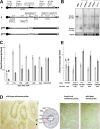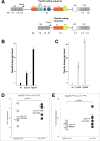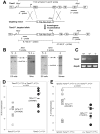Two isoforms of the RAC-specific guanine nucleotide exchange factor TIAM2 act oppositely on transmission ratio distortion by the mouse t-haplotype
- PMID: 30817801
- PMCID: PMC6394906
- DOI: 10.1371/journal.pgen.1007964
Two isoforms of the RAC-specific guanine nucleotide exchange factor TIAM2 act oppositely on transmission ratio distortion by the mouse t-haplotype
Abstract
Transmission ratio distortion (TRD) by the mouse t-haplotype, a variant region on chromosome 17, is a well-studied model of non-Mendelian inheritance. It is characterized by the high transmission ratio (up to 99%) of the t-haplotype from t/+ males to their offspring. TRD is achieved by the exquisite ability of the responder (Tcr) to trigger non-Mendelian inheritance of homologous chromosomes. Several distorters (Tcd1-Tcd4), which act cumulatively, together promote the high transmission ratio of Tcr and the t-haplotype. Molecularly, TRD is brought about by deregulation of Rho signaling pathways via the distorter products, which impair sperm motility, and the t-sperm specific rescue of sperm motility by the responder. The t-sperm thus can reach the egg cells faster than +-sperm and fertilize them. Previously we have shown that the responder function is accomplished by a dominant negative form of sperm motility kinase (SMOKTCR), while the distorter functions are accomplished by the Rho G protein regulators TAGAP, FGD2 and NME3 proposed to function in two oppositely acting pathways. Here we identify the RAC1-specific guanine nucleotide exchange factor TIAM2 as modifier of t-haplotype TRD. Tiam2 is expressed in two isoforms, the full-length (Tiam2l) and a short transcript (Tiam2s). Tiam2s expression from the t-allele is strongly increased compared to the wild-type allele. By transgenic approaches we show that Tiam2s enhances t-haplotype transmission, while Tiam2l has the opposite effect. Our data show that a single modifier locus can encode different gene products exerting opposite effects on a trait. They also suggest that the expression ratio of the isoforms determines if the outcome is an enhancing or a suppressive effect on the trait.
Conflict of interest statement
The authors have declared that no competing interests exist.
Figures




Similar articles
-
The nucleoside diphosphate kinase gene Nme3 acts as quantitative trait locus promoting non-Mendelian inheritance.PLoS Genet. 2012;8(3):e1002567. doi: 10.1371/journal.pgen.1002567. Epub 2012 Mar 15. PLoS Genet. 2012. PMID: 22438820 Free PMC article.
-
The t-complex-encoded guanine nucleotide exchange factor Fgd2 reveals that two opposing signaling pathways promote transmission ratio distortion in the mouse.Genes Dev. 2007 Jan 15;21(2):143-7. doi: 10.1101/gad.414807. Genes Dev. 2007. PMID: 17234881 Free PMC article.
-
A protein kinase encoded by the t complex responder gene causes non-mendelian inheritance.Nature. 1999 Nov 11;402(6758):141-6. doi: 10.1038/45970. Nature. 1999. PMID: 10647005
-
Transmission ratio distortion in mice.Annu Rev Genet. 2003;37:393-408. doi: 10.1146/annurev.genet.37.110801.143030. Annu Rev Genet. 2003. PMID: 14616067 Review.
-
[Transmission ratio disruption, sterility, and control of t-complex function in sperm].Genetika. 2001 Sep;37(9):1198-206. Genetika. 2001. PMID: 11642122 Review. Russian.
Cited by
-
Mechanisms of meiotic drive in symmetric and asymmetric meiosis.Cell Mol Life Sci. 2021 Apr;78(7):3205-3218. doi: 10.1007/s00018-020-03735-0. Epub 2021 Jan 15. Cell Mol Life Sci. 2021. PMID: 33449147 Free PMC article. Review.
-
'Fat's chances': Loci for phenotypic dispersion in plasma leptin in mouse models of diabetes mellitus.PLoS One. 2019 Oct 29;14(10):e0222654. doi: 10.1371/journal.pone.0222654. eCollection 2019. PLoS One. 2019. PMID: 31661517 Free PMC article.
-
Meiotic drive in house mice: mechanisms, consequences, and insights for human biology.Chromosome Res. 2022 Sep;30(2-3):165-186. doi: 10.1007/s10577-022-09697-2. Epub 2022 Jul 13. Chromosome Res. 2022. PMID: 35829972 Free PMC article. Review.
-
Novel patterns of expression and recruitment of new genes on the t-haplotype, a mouse selfish chromosome.Proc Biol Sci. 2022 Feb 9;289(1968):20211985. doi: 10.1098/rspb.2021.1985. Epub 2022 Feb 9. Proc Biol Sci. 2022. PMID: 35135349 Free PMC article.
-
TIAM-1 differentially regulates dendritic and axonal microtubule organization in patterning neuronal development through its multiple domains.PLoS Genet. 2022 Oct 12;18(10):e1010454. doi: 10.1371/journal.pgen.1010454. eCollection 2022 Oct. PLoS Genet. 2022. PMID: 36223408 Free PMC article.
References
-
- Burt A, Trivers R. Genes in conflict: the biology of selfish genetic elements Cambridge, Mass: Belknap Press of Harvard University Press; 2006.
-
- Herrmann BG, Bauer H. The mouse t-haplotype: a selfish chromosome–genetics, molecular mechanism, and evolution. Evolution of the House Mouse. 2012:297–314.
-
- Artzt K, Shin HS, Bennett D. Gene mapping within the T/t complex of the mouse. II. Anomalous position of the H-2 complex in t haplotypes. Cell. 1982;28(3):471–6. Epub 1982/03/01. 0092-8674(82)90201-X [pii]. . - PubMed
Publication types
MeSH terms
Substances
LinkOut - more resources
Full Text Sources
Molecular Biology Databases
Research Materials
Miscellaneous

